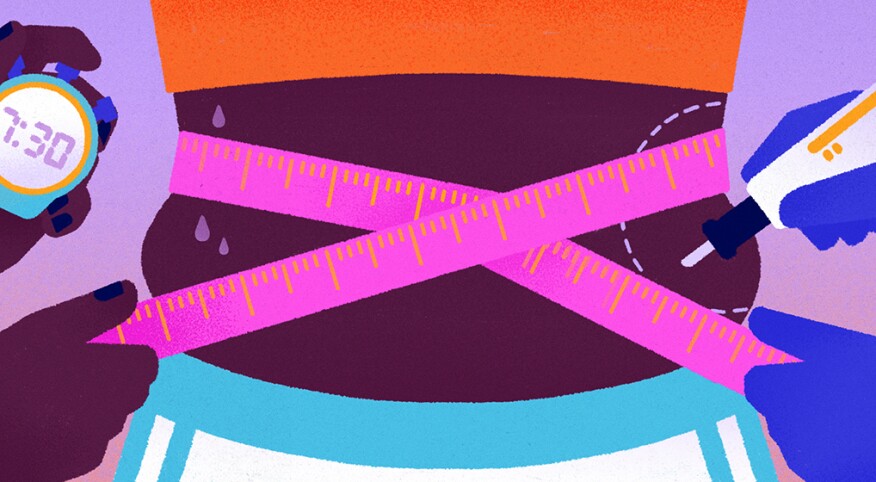First of all, we’re here for curves. And we love that the fashion industry has finally begun embracing real bodies, extending sizes, casting models with fleshier figures and forgoing photoshopping every ripple and fold. What’s most important is that we feel good in our bodies, loving every inch because it’s ours. The thing is, because of the way the pandemic changed our eating and activity habits, some people don’t feel so at home in their own skin right now (like a 55-year-old girlfriend of mine whose rapid weight gain means suddenly she can grab a handful of belly fat rather than a pinch). It’s for folks like her that we’re discussing “middle management” here.
“I personally do not measure waist to hip ratio or BMI. I generally go by how I personally feel in my body,” says Bridgette Duncan, certified personal trainer, Pilates instructor and owner of Slam Duncan Wellness in New York City. “I feel best and look my best when I am consistent with a well-balanced diet, consistent physical activity and keeping my stress level low. That is my measure. When do you feel happiest and healthiest in your body? That should be your indicator; however, when the retention of fat starts to inhibit your ability to live your particular lifestyle, then adjustments should be made.” Duncan suggests speaking with your health care provider to discuss whether the amount of fat you have is too much for your body.
The lowdown on love handles
So what causes those difficult to shrink pockets of fat? Simply put, love handles or “flanks” are caused by fat retention, and some people can be genetically predisposed to developing them, confirms Duncan. “Society often doesn’t talk about the lifestyle changes that can cause someone to develop and retain fat in certain areas of the body,” she adds. “For example, sitting for longer periods of the day can cause an actual shift in where your body retains subcutaneous fat.”
Fortunately, subcutaneous fat, which is located just beneath the skin, is not as dangerous as visceral fat, the hidden fat deep within the abs that surrounds the organs and can lead to chronic disease. “It is the kind of fat you can pinch and visibly see,” says Duncan. “At times it can make you feel uncomfortable in your clothing. Genetics and hormones are the first determining factors for how much subcutaneous fat you may have. With that aside, people typically have greater amounts of subcutaneous fat due to eating more calories than they’re burning, stress levels and having a sedentary lifestyle. These are the largest contributors to the amount of fat that we gain and retain.”
Subcutaneous fat is important to our bodies, Duncan adds. “We all need a fair amount of it on our bodies because it helps with hormone regulation in all humans, regulating body temp and many other things.” It’s the excess fat that is of concern. The good news is that reducing subcutaneous fat can also help with reducing visceral fat.
How do you get rid of love handles?
To reduce love handles you need to watch what you eat and reduce food portions if necessary. Add in adequate physical activity — a combination of abdominal exercises, strength training and cardio (aerobics) and exercises that target the obliques and the core. “Spot reduction doesn’t work,” Duncan explains. “Spot reduction is the belief that you can do an exercise for a certain area of your body and you will lose fat/weight in that specific area. This is a myth. We are not able to control where we lose fat in our bodies. Our bodies have a lot of chemical and physical processes that must happen for us to lose weight. That process looks radically different from person-to-person.”
“Strengthening muscles will always give the body, a toner, firm and solid look,” she continues. “That is a by-product of the exercise; not spot reduction.” Good exercises to try are Russian twists, oblique crunches, jumping burpees, ab bicycles and side planks. Adding strength training with weights builds muscle that will help you burn more calories and lose fat.
Duncan has created a YouTube channel, Slam Duncan Wellness, that features fitness videos. The first video targets exercises for the abs and obliques. She also has short videos on her Instagram page @slamduncanwellness that don’t take up a lot of time and can easily be implemented into your daily routine. Check with your doctor before you start any exercise program.
For those considering cosmetic treatments
If you’re concerned about stubborn fat that won’t go away with a healthy diet and exercise, cosmetic procedures like liposuction and treatments that use cryolipolysis, radio-frequency or ultrasound are some of the options for fat reduction and removal, says dermatologist Kesha Buster, based in Tulsa, Oklahoma.
Talk to your doctor before having any cosmetic procedures. Some procedures should be avoided if you have certain medical conditions. Also, cosmetic procedures can be expensive and are not covered by health insurance. Learn all you can about a procedure before making a decision. When considering a treatment, research the credentials of board-certified cosmetic surgeons and dermatologists and have a consultation to discuss whether a procedure is right for you and has any potential side effects. Get real testimonials and before and after photos. “There is no blanket fat-reduction procedure to be avoided in Black women (to my knowledge),” says Buster, “but the best choice for each patient should be determined by the patient and her board-certified dermatologist or plastic surgeon, depending on the procedure she is considering.”

Maria Hergueta










